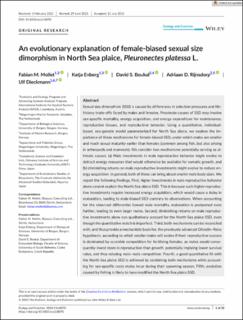| dc.description.abstract | Sexual size dimorphism (SSD) is caused by differences in selection pressures and life-history trade-offs faced by males and females. Proximate causes of SSD may involve sex-specific mortality, energy acquisition, and energy expenditure for maintenance, reproductive tissues, and reproductive behavior. Using a quantitative, individual-based, eco-genetic model parameterized for North Sea plaice, we explore the importance of these mechanisms for female-biased SSD, under which males are smaller and reach sexual maturity earlier than females (common among fish, but also arising in arthropods and mammals). We consider two mechanisms potentially serving as ultimate causes: (a) Male investments in male reproductive behavior might evolve to detract energy resources that would otherwise be available for somatic growth, and (b) diminishing returns on male reproductive investments might evolve to reduce energy acquisition. In general, both of these can bring about smaller male body sizes. We report the following findings. First, higher investments in male reproductive behavior alone cannot explain the North Sea plaice SSD. This is because such higher reproductive investments require increased energy acquisition, which would cause a delay in maturation, leading to male-biased SSD contrary to observations. When accounting for the observed differential (lower) male mortality, maturation is postponed even further, leading to even larger males. Second, diminishing returns on male reproductive investments alone can qualitatively account for the North Sea plaice SSD, even though the quantitative match is imperfect. Third, both mechanisms can be reconciled with, and thus provide a mechanistic basis for, the previously advanced Ghiselin–Reiss hypothesis, according to which smaller males will evolve if their reproductive success is dominated by scramble competition for fertilizing females, as males would consequently invest more in reproduction than growth, potentially implying lower survival rates, and thus relaxing male–male competition. Fourth, a good quantitative fit with the North Sea plaice SSD is achieved by combining both mechanisms while accounting for sex-specific costs males incur during their spawning season. Fifth, evolution caused by fishing is likely to have modified the North Sea plaice SSD. | en_US |
